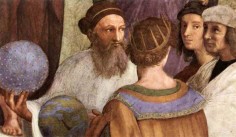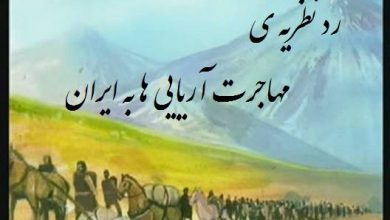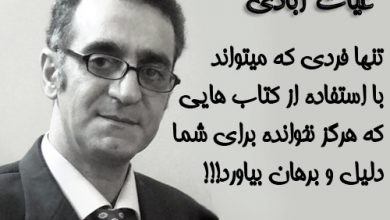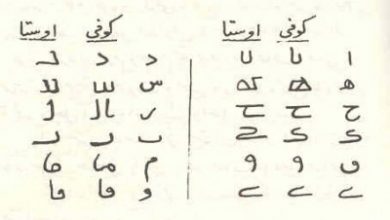The influence of Zoroaster on Europe
We all know that the experience of the past is the light of the present and the future.
And in this regard, I believe that Europe's experience to gain freedom and rebuild a new identity for itself, which started from the Renaissance period and the important role that Zoroaster played in this field for 500 years, that is, from the 15th century to the end of the 19th century.
It can be used as one of the best models for freedom seekers in our time.
Countless researches from 200 years ago – most of which were done by western researchers - it shows how much Zoroastrian thought and view about life and the universe participated in and influenced the European cultural structure and infrastructure in the last 2500 years. .
But for this very long time, Europe's relationship with Zoroaster was not always a story of love and affection.
There was a time when Europe placed Zoroaster in its highest cultural category and there was a time when it tried as much as possible to destroy him and throw him out of the arena with poisonous propaganda..
In 1000 years, From the 5th century BC to the 5th century AD, Zoroaster as the "greatest symbol of knowledge" was admired and even worshiped by almost all Greek and Roman philosophers with fascination, to the point where they were given the name "universal teacher"..
Continue to download all of this article in PDF form in the following article
But during the next 1000 years, that is, from the 5th century to the 15th century, in the era that is called the "Middle Ages", Zoroaster as the creator of "dualism" was severely beaten by the Christian Church..
And with Zoroastrian's defeat, other Iranian religions such as Mehr Satai (Mithraism) and Monism were defeated along with all the Platonic philosophers of Greece and Rome..
The sixth century was the beginning of the "Middle Ages" in Europe. A terrifying era that is called the "great blasphemy"..
An era full of terror, Blindness and excision that destroyed the most beautiful and delicate part of European civilization.
The medieval church decided that every thought, every world view and every movement that introduces the idea of "dualism" into the Christian religion is at war with God.. And therefore, it should be punished, and punishment means burning in the city squares or killing.
behind the philosophy of "dualism"- That is, life and the universe are formed at every moment by the battle between two self-creating forces, positive and negative, good and bad - the church saw Zarathustra's hand. And by attacking Zarathustra, the Church attacked all the pre-Christian civilizations in Europe.
But the truth was that the priests at that time did not know anything about Zoroaster. Their only knowledge about this came from Greek and Roman philosophers.
These philosophers, most of whom were dualists, had either assigned their writings to Zoroaster, or had hidden behind the name of Zoroaster to give themselves credit.. For example, Pythagoras, a philosopher and mathematician of the fifth century BC, who was a dualist, In his writings, he introduced himself as a student of Zoroastrianism or a student of the Zoroastrian school, Or a philosopher by another name, Aristotle, He writes that all the knowledge of his teacher is Plato, who was also a dualist, It comes from Zoroaster and he repeated what Zoroaster said.
On the other hand, "manyism" or “Manithéisme” Another Iranian religion, that he was also "dualist"., In the form of "Catherism" in the south of France and North Africa and dozens of different movements around the Mediterranean Sea and Central Europe, all Christian but dualist., They increased the anger of the church towards Zoroaster, Because behind all these movements, Again, the church was the hand of Zarathustra.
50 years of bloody war in the 13th century, Pope Itossaint unleashed against the "Cathers" in the south of France and a terrible massacre in the city”Montsegour ” The dams killed thousands of people, today they have gained world fame and every year thousands of tourists who go to the south of France visit the ruins of this city..
The more we know about the crusades of the Catholic Church, one after the other, against the movements that “Dualism” They were accused, we read, We understand more about the nature of our present-day greedy and violent regimes.
It goes without saying that the Protestant Church distanced itself from the Catholic Church regarding these killings and condemned them..
Ignorance and confusion in medieval Europe about Zarathustra, It progressed as much as during all this time, Zarathustra “The prince of mages” They called and confused magicians with magicians. The English word "Magician" originates from the word "Magus" which means "magus". In this context, the invention of astrology and alchemy and the writing of Jewish Kabbalah were also attributed to Zoroaster..
In this space full of ignorance, It was suffocation and blindness that disgruntled voices were raised from this corner of Europe by some rationalists..
* * *
We are in the 14th century AD, And this is the beginning of the era when the renaissance means cultural resurrection is slowly coming to life in Europe. Europe is looking for a new identity with new cultural values for itself., is in search. And this search made him realize his past, that is, the civilization of Greece and Rome.
At that time, in the circles of rationalists, the discussion was about saving the church from being suffocated, The only way to escape is cultural struggle. But a cultural struggle needs fighting tools, It needs his values.
Where could Europe find this tool?
In the pre-Christian civilization, that is, in the civilization of Greece and Rome . Mayba Yesti went to the heart of these civilizations, brought out the cultural values and gave life to them.
But the civilization of Greece and Rome had been forgotten for centuries. Therefore, everything must be discovered anew.
at this time, One of the greatest philosophers of this period named Giorgius Platon, who had gained a lot of political influence in the court of the Byzantine Empire, made a surprising but brave proposal., Christianity and Islam are tired and there is no hope to end these wars. Therefore, let's take another way to save the future generations of this world.
Plato, who was assigned to him with the thoughts of Zarathustra or whatever, By my Jewish teacher “Elias” He had become familiar with these thoughts,He suggested that a universal thought, A mixture of Zoroastrian worldview and Plato's philosophy, replace the three religions mentioned.
Many intellectuals and statesmen of that time liked this proposal and gathered around him and tried for years to implement this vision, but they did not succeed.. However, this thought flourished among a wide range of thinkers and entered the famous Platonic Academy of Florence in Italy and became a basis for building European humanism in the 16th century..
After this, European rationalists again noticed Zoroaster. The battle of the cultural seekers of that time, It means philosophers, The writers, poets, researchers, Musicians, Scientists in various scientific fields and many others in search of a powerful tool to fight against the suffocation of the medieval church felt that Zoroaster could help them in this way..
But at that time, Did he really know about Zarathustra? Who knew that this Zoroastrian worldview was based on what principles? who knew if Zoroaster was really a dualist, monotheist, Or both or neither? It was at least 1500 years ago that even the Zoroastrian language was forgotten.
On the other hand, the conquest of Iran in the 7th century by Arab Muslims, He had burnt and destroyed almost all the writings and books related to Zoroastrian or Iranian civilization. Therefore, everything has to be discovered anew. But this is an effort to rediscover Zoroastrian worldview and language, Another battle, this time between Jewish researchers, Christian and humanist created .
In this fight, Each group of these researchers tried to use their own interpretations of the writings that were assigned to Zoroaster to draw Zoroaster towards them as a tool of battle..
The first action in this regard was started by Christian researchers. At this time, That is, at the end of the 17th century, One of the professors of Oxford University in England named Thomas Hyde, who was a very faithful Christian, wrote a big book about Zoroaster and brought all the evidences that existed about it at that time in that book..
Although he worked very hard in this way, but unfortunately, because everything revolves around Christianity for him in this world., He tried to bring Zoroaster as close to Christianity as possible.
He wrote in his book that “Zoroaster by reforming the past religions of Iran, He repeated what Abraham had done and brought a monotheistic religion”.
He emphasized that “Zoroastrians were always monotheists in that religion, God, who is called Ahura Mazda, is preferred over Satan, who is called Angre Mino”.
This view, of course, is completely contrary to the view of the Greek and Roman philosophers and the medieval church that Zoroaster “dualist” It was thought that just two years after writing this book, Hyde was severely attacked by two French Christian researchers: The first of these researchers was named Pierre Bayle; A famous French researcher in 1702 in an important book called “Historical and critical dictionary” wrote that “Hyde's writings about weak Zoroastrian monotheism, It is fragile and wrong”.
He wrote that “Because the Zoroastrians were severely oppressed by the Muslims, In order to protect and maintain themselves, they had to follow the beliefs of the Semitic religions, which say that God created the devil, to accept”.Soon Bayle was supported by another French researcher, It was called Able Foucher. Foucher, who was a Christian fundamentalist, in many of his writings violently warned Hyde that, according to the Greek and Roman philosophers who wrote Zarathustra, “Dualistic” They said not to doubt, And he suggested Hyde, who was a very devout Christian himself, to remain in the line of the true religion, i.e. Christian.
In this ideological battle, which had deviated from the right path due to the extreme religious orientation of the researchers, A researcher by another name, This time, an English Jew named Hemyhry Prideaux, entered the battlefield, Prideaux in an important book about “History of the Jews” which was printed in 1715, He took his statements about Zoroaster to the point where he wrote: Zarathustra was born a Jew! And because he is a Jew, therefore he is a monotheist. He placed the birth date of Zoroaster in the 5th century BC and also called Zoroaster's teachers Elias., It also identified Ezra and Daniel. With the rediscovery and translation of the Avesta, At the end of the 19th century by a French researcher, This time it was the turn of rationalists and humanists to enter this ideological battle.
Translation of Avesta,It turned the battle about Zarathustra into an emotional and passionate battle.
Famous writers from the four corners of Europe such as Voltaire, Goethe, Diderot, Grimm, Von Kleist Wordsworth, Byron Shelley, Nietzsche and many others entered the battlefield from the end of the 18th century and throughout the 19th century.. Great musicians also joined this cultural struggle. The great French composer Rameau named his famous opera “زرتشت” made, Mozar, another great composer of Zarathustra, in his opera “No magic” brought and called Richard Strauss his symphony “Zarathustra said so” Zarathustra created in glory.
The advantage that the enlightened Europeans saw in bringing Zoroaster to the battlefield was that they thought that they could use Zoroaster as a powerful weapon against the church.. For them, the church no longer had the monopoly on truth. The truth could exist in a non-Semitic religion much older than Christianity.
As Professor Duchenne Gaiman in his book “The West's answer to Zarathustra” writes “More and more, Zoroaster became an important part of the activities that were carried out in Western Europe to liberate modern men and women from Christianity.”.
The characteristics of Zoroastrian's worldview, which the rationalists said did not exist in Christianity, were highly praised., Including: rationalism, Transparency and simplicity, Communication with nature, Creating a positive and constructive point of view, above all, was the problem of the devil and suffering and pain in this world.
They said that Zoroaster solved the problem of suffering and pain in this world with the theory of "dualism" with great wisdom, while the Semitic religions, which claim that Satan is created by God, have been solving this problem for thousands of years. are helpless.
Because they cannot say why God, who is both knowledgeable and powerful, created a creature called Satan to deceive the weak humans created by the same God and then burn them in the eternal fire of hell.. Therefore, God is either not wise, or not powerful, or evil in his nature..
They accused Anguetil Duperron that his translation of the Avesta is fake and false, and in this poisonous atmosphere, Duperron, who was himself a devout Christian, withdrew and said, "I did not see anything in the Avesta that could be used against Christianity.".
This statement made the rationalists a little disappointed and discouraged, however, Voltaire praised Duperron's efforts in a letter..
It was at this time that linguists also entered the battlefield. Three years later, another translation of the Avesta by a German linguist named Kleukers proved that Duperron's translation was correct and that there was no tampering in it.. Since then, Avesta entered academic and university education forever.
Even though everyone confirmed the truth of the Avesta and included it in scientific research, it took another 30 years for the Christian partisans to lay down their arms and surrender.. Since then, researchers have found the roots of Christianity in the heart of Zoroastrian worldview. The discovery of the Sanskrit language and the relationship between this language and the Avesta language made it easier to understand the Avesta writings and showed the common roots between the civilizations of Iran and India..
Another victory was coming for the rationalists and humanists. In the middle of the 19th century, one of the German linguists named "Martin Haug" discovered that 17 of the 72 parts of the Avesta are much older than the other parts of his writing. After much effort, he separated and translated these 17 parts.. Later linguistic researches proved with complete surprise that these 17 parts or 17 hymns called "Gathas" came out of Zoroaster's mouth 3000 years ago. Hogg realized that only one god was mentioned in the Gathas and that is "Ahura Mazda". and although these poems are from ” Two opposite forces” He speaks, but in general, the atmosphere of the poems directs man towards a single God, and this is exactly opposite to other parts of the Avesta, which clearly speaks of two opposite forces, "Good and Evil, Ahura Mazda and Angra Maino"..
Martin Hogue's discovery was met with an unprecedented welcome by the Persians of India, because it pointed to the monotheism of Zoroastrian worldview..
But the acceptance of the idea that Zoroastrian thought is the source of monotheism in world religions and that Zoroaster is the discoverer of monotheism was not acceptable to some researchers, especially the Jews, and they could hardly digest it..
Including Spiegle and Darmesteter, two famous German researchers started their counterattack against the Gathas this time. Spiegle tried to prove that it was the Jews who taught Zoroaster monotheism, and Darmesteter went even further and claimed that all the Gathas were fake. It was written by Jews who were under the influence of Greece !
Of course, none of these two claims could resist for a long time. Because some time later archeological and linguistic studies showed that Zoroaster's place of life was in the east of Iran and Jews had not penetrated there, and on the other hand, Darmesteter revised his claim and invalidated it..
Such claims caused other researchers such as Rhadl and Creuzer, two famous German researchers, to say and try to prove that Western and Eastern culture and all cultures in general originated from Zoroastrian thought.. Maybe this was a sharp reaction against the strong theories of the opposite direction, but this was a diagram of the ideological atmosphere of those days..
Only a few years after the Gathas were rediscovered and translated, their essence was rewritten in 1883 with skillful beauty and depth by one of the greatest philosophers of our time, Friedrich-Wilhelm Nitzsche. ” Zarathustra said so ” was named, it shows how much Nietzsche understood the depth of Zoroastrian's revolutionary thought and with what skillful method he showed the dynamism and innovativeness in Zoroastrian's worldview. and saved them from sins they had never committed. Dear friends, ladies and gentlemen, I would like to finish my speech with a quote from Nietzsche.:
” I am from yesterday and I am from today; But a part of me is from tomorrow, after tomorrow, and forever” "That's what Zarathustra said"
Click on the link below to download the book Zoroaster and the Europeans







